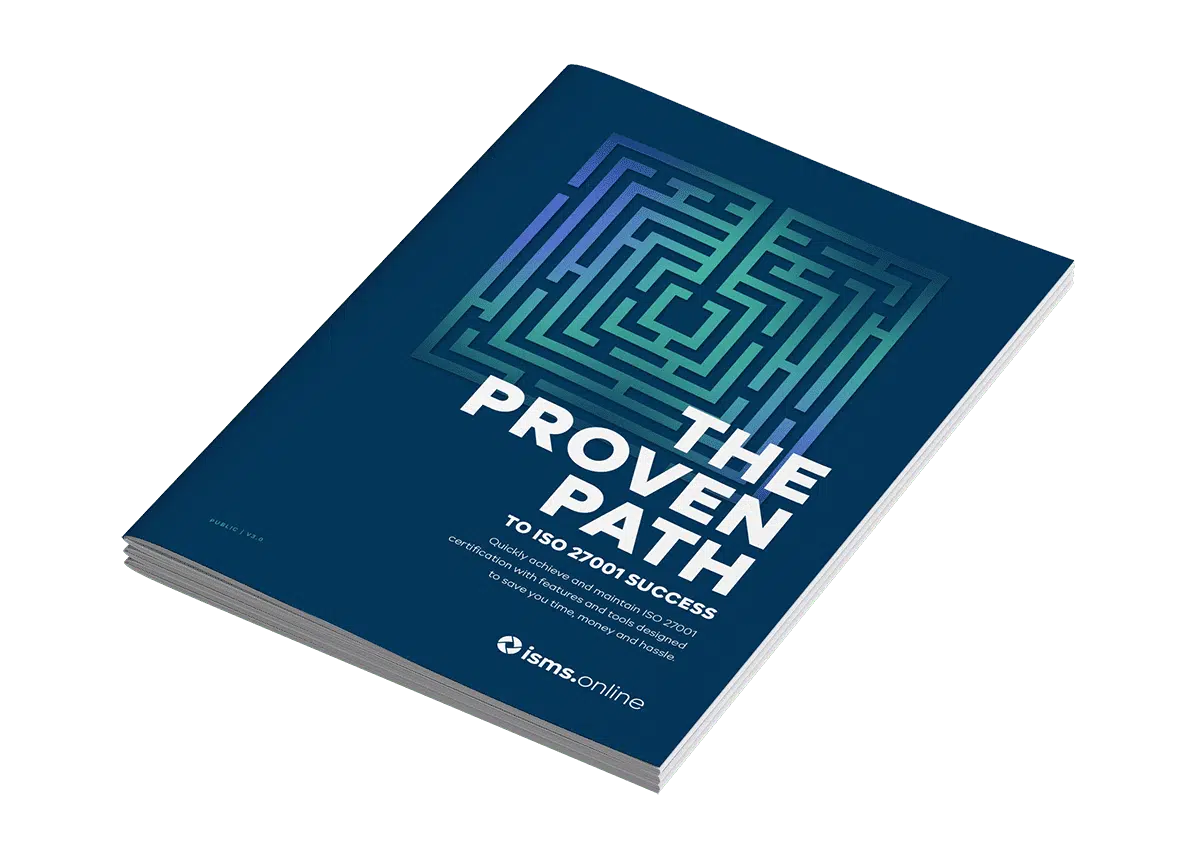
Cybersecurity continues to be a potent concern globally. As cyber threats evolve, organisations must adopt comprehensive measures to protect vital information assets. Two critical tools that organisations can leverage to improve their cybersecurity posture are the Cybersecurity Maturity Model Certification (CMMC) and ISO 27001.
The Cybersecurity Maturity Model Certification (CMMC) model was designed by the Department of defence (DoD) to enhance the cybersecurity procedures of companies operating within the defence Industrial Base (DIB). It comprises five distinct levels ranging from basic cyber hygiene practices at Level 1 to advanced/progressive practices at Level 5. These levels present an incremental and actionable framework for organisations to assess, implement, and enhance their cybersecurity protocols.
Simultaneously, ISO 27001 is an international standard for Information Security Management Systems (ISMS). It offers a systematic approach to manage sensitive company information by implementing a robust security management framework. organisations achieving ISO 27001 certification have proven their ability to effectively secure their information resources, thereby gaining the trust of partners and clients.
Interestingly, ISO 27001 and CMMC are not mutually exclusive. In fact, an organisation with a robust ISMS based on ISO 27001 has a foundational head-start towards CMMC. Implementing ISO 27001 is not merely a prerequisite to achieve ISO 27701 certification, but its robust, procedural, risk-based approach echoes with CMMC's systematic risk management focus.
Thus, if your organisation already complies with ISO 27001, you're already on the path towards CMMC maturity. Conversely, organisations aspiring to achieve CMMC can solidify their efforts by adopting ISO 27001 practices. Both these security standards, when implemented effectively, can work synchronically, providing your organisation a more comprehensive and resilient approach to tackle evolving cyber threats.
Overall, integrating CMMC and ISO 27001 can help your organisation enhance its cybersecurity protocols, meet legal and regulatory requirements, and maintain the trust of stakeholders.
With an understanding of our evolving cybersecurity landscape, the interplay between the Cybersecurity Maturity Model Certification (CMMC) and ISO 27001 becomes a pivotal focus. CMMC, with its sharpened approach towards Controlled Unclassified Information (CUI), strengthens ISO 27001's existing cybersecurity tenets to provide a holistic measure of cybersecurity preparedness.
Providing a tangible progression path across five maturity levels, CMMC lays a roadmap for ramping up CUI security. Graduation from one maturity level to the subsequent one represents an enhancement in cybersecurity practices and aligns with the central philosophy of continuous improvement embedded within ISO 27001's Information Security Management Systems (ISMS).
ISMS.online, built on ISO 27001 principles, acknowledges this deep-rooted synergy between CMMC and ISO 27001. Our platform provides a robust framework assisting businesses in these intertwined standards, effectively encapsulating the spirit of both.
Fusing CMMC and ISO 27001 into a comprehensive data security strategy brings forth several advantages. Combining these robust standards builds a sturdier, more resistant security framework. This strategic blend, simplified by ISMS.online, assures not just improved security but also paves the way for adaptive business operations. ISMS.online streamlines compliance, generating invaluable insights that promote a security-centric culture, resulting in a significant return on investment.
On this note of leveraging this integral relationship between CMMC and ISO 27001, businesses can harness a comprehensive security strategy. Such a harmonised approach to security helps organisations flourish in the dynamic cyber landscape. Platforms like ISMS.online serve as reliable allies in this journey towards unison in compliance. The exploration of cybersecurity, however, doesn't end here; businesses can take advantage of other frameworks to further reinforce their defences, which we'll delve into in the following discussion.
Request a quote

ISO 27001 outlines an exhaustive suite of requisites aimed at enabling organisations to establish, operate, and continually enhance an Information Security Management System (ISMS). It provides a structural framework incorporating legal, physical and technical controls aimed at efficiently managing information risks.
At the core of ISO 27001 lies its six-part planning process that forms the backbone of an effective ISMS.
The Six-Part Planning Process
The foundation of ISO 27001 rests on a 'plan-do-check-act' (PDCA) methodology. This approach advocates for an ongoing cycle of improvement which is not a one-time procedure but a continual process that takes place throughout the lifecycle of an ISMS, contributing to the principle of continual enhancement.
When examining the key principles of the Cybersecurity Maturity Model Certification (CMMC), it becomes apparent that there is a strong alignment with ISO 27001. Both of these standards emphasise frequent risk assessments and proactively managing those risks as essential components of securing information.
There are clear parallels when we consider specific practices within the CMMC and their alignment with the principles within ISO 27001. For example, CMMC's practice RA.2.142 emphasises the requirement for periodic risk assessments, clearly mirroring ISO 27001's 'Risk Assessment' phase. Additionally, CMMC's practice RM.3.143 focuses on managing risks through a documented process, aligning with the 'Risk Treatment' phase in ISO 27001.
A specific example of direct alignment is ISMS control A.5.9 from ISO 27001's Annex A, which focuses on the management of an asset inventory, aligning perfectly with CMMC's practice AM.2.036.
By embracing ISO 27001 principles within its framework, an organisation can streamline its path towards achieving CMMC compliance. This strengthens its approach to data security and bolsters stakeholder trust while addressing the Department of defence's (DoD) contractual requirements, which in turn enhances its reputation and credibility in the marketplace.
CMMC and ISO 27001, while being comprehensive and robust security standards, exhibit unique characteristics, resulting in their varying impacts on an organisation's security strategies.
CMMC, with its in-depth specifications and benchmarks, provides a stringent framework catering specifically to the Department of defence's supply chain. It encompasses five tiers, escalating in complexity and thoroughness, focusing on the progression from basic cyber hygiene to advanced practices.
Alternatively, ISO 27001 offers flexibility in implementation, granting organisations the liberty to devise a customised security strategy. Tailored risk assessments and identification of applicable controls form the basis of the Information Security Management System (ISMS) under ISO 27001.
Despite the stark contrast in their approach, there is an apparent intermingling in the broad security objectives, reinforcing the importance of common practices such as risk assessments and incident response management. However, the requirement to achieve full compliance with all practices in CMMC, irrespective of the risk context, starkly contrasts with the risk-driven, tailored approach of ISO 27001.
In the midst of these contrasts and intersections, ISMS.online can form a foundation for meeting the requirements of both the standards. The platform's comprehensive features align with the objectives of retaining control over information, demonstrating compliance and achieving continuous improvement, which are pivotal in both ISO 27001 and CMMC.
It is vital to recognise the unique strengths and directives of CMMC and ISO 27001, enabling an organisation to leverage these standards in a manner that supports their specific security goals. Understanding their interplay can contribute immensely to shaping an effective and efficient security strategy.
Integrating CMMC and ISO 27001 is not a straightforward task due to their distinct purposes and structures, which is further complicated when applying them to organisations operating in multi-sector industries. For instance, consider a multinational corporation providing services in the defence, health, and finance sectors. Aligning the compliance requirements of this diverse landscape to a singular standard can pose significant complexities.
Firstly, let's delve into the issue of alignment of scopes. CMMC and ISO 27001 have discrete compliance requirements. As you might know, CMMC emphasises on the safeguarding of Federal Contract Information (FCI) and Controlled Unclassified Information (CUI). Contrastingly, ISO 27001's focus lies in the establishment of broad information security protocols. Consequently, the compliance requirements differ, demanding adjustments in the organisations' current security protocols and policies.
Mapping the five maturity levels of CMMC to the risk-based approach of ISO 27001 can pose another challenge, primarily due to the contrast in their structures and terminologies. The levels of CMMC from "Basic Cyber Hygiene" to "State of the Art" do not directly correlate to any specific level of risk mitigation in ISO 27001. This lack of direct mapping can create confusion for organisations attempting to integrate both standards.
Resource allocation is another aspect of concern when consolidating these frameworks. For example, achieving CMMC Level 3 compliance could require substantial investment in both implementing and subsequently maintaining the necessary controls. organisations could face significant time and financial costs, not to mention the potential need for additional personnel or external consultants to manage the compliance process.
Thus, while the integration of CMMC and ISO 27001 presents numerous potential advantages, achieving this integration is a complex task that requires careful planning, resource allocation, and a deep understanding of the compliance requirements and structures of both standards. The goal is not impossible, but it does demand comprehensive, dedicated effort.
An integrated application of the Cybersecurity Maturity Model Certification (CMMC) and the ISO 27001 framework remains our recommended path for organisations aiming for a formidable security posture. This influential combination significantly augments cyber defence measures and conveys an unwavering commitment to data integrity.
When we intertwine the specifics of CMMC with the comprehensive approach of ISO 27001, a noteworthy strengthening of your organisation's cyber barriers transpires. This union offers a well-rounded security shield, crucial for standing against the multitude of cyber threats plaguing today's digital ecosystem.
The convergence of CMMC and ISO 27001 enhances the comprehensiveness of cybersecurity measures. This coupling amplifies defence mechanisms and unequivocally exhibits our dedication to consistently safeguard sensitive data.
An essential facet of this coalescence is the promotion of a risk-based strategy tailored to your company's unique threat landscape. Such an approach ensures that resources are deftly allocated to fortify high-risk areas. For instance, more resources can be funnelled towards strengthening firewalls if a high influx of attempted breaches is detected, optimising both the efficiency and the efficacy of your cybersecurity measures.
The multi-disciplinary approach provided by the integration of CMMC and ISO 27001 amplifies security measures and expedites the steps towards achieving exemplary compliance levels. Navigating and mitigating the complexities of integration are surmountable challenges when compared to the compelling benefits garnered from this potent alliance.

Book a tailored hands-on session
based on your needs and goals
Book your demo
Establishing a resilient security framework hinges on the intelligent alignment of crucial procedures and controls within an organisation. In this context, CMMC and ISO 27001 step into the spotlight. The focus must be on strategic alignment as opposed to indiscriminate amalgamation, thereby fostering efficient and effective implementation.
To put it in perspective, the strategic alignment of CMMC and ISO 27001 isn't a standalone task but an ongoing commitment. This continual process of aligning, reassessing, and re-aligning keeps your organisation abreast with the ever-evolving standards. The mindful application not only conserves resources and enhances efficiency but also notably augments the security stature of your organisation. Incorporating this alignment mechanism within your organisation's daily operations lays the groundwork for a secure and adaptable working environment.
Understanding the full expanse of the frameworks, identifying potential hurdles, developing a customised approach, and leveraging external expertise judiciously form the cornerstones of a triumphant journey towards implementing CMMC and ISO 27001 in your organisation.
Both CMMC and ISO 27001 provide guidelines and requirements that inform decision-making processes in the implementation of cybersecurity controls. Having a comprehensive understanding of the frameworks gives your organisation a robust foundation to embark on the journey of implementation.
The introduction of any new process can lead to potential obstacles. Early recognition and strategic planning to mitigate these challenges smooth the path towards successful adoption. The key challenges include:
The inherent complexity of CMMC and ISO 27001 might necessitate the need for external consultation. Discerning when and what type of expertise is required is pivotal and depends on your understanding of the frameworks, the complexities specific to your organisation, and your internal ability to meet the standards' requirements. Knowledge gaps, resource limitations, and complex procedures might indicate the need for external support.
With these strategies at your disposal, your organisation is well-positioned to navigate the intricate process of CMMC and ISO 27001 adoption. Always remember, it is the routine management and review that contribute significantly to maintaining compliance and fueling continuous improvement.
The evolving landscape of cybersecurity presses organisations to maintain unyielding security postures. A direct way to make this happen is to become certified in the Cybersecurity Maturity Model Certification (CMMC) and ISO 27001. Aligning these frameworks with your organisation's security programme positions the organisation favourably amidst the cybersecurity demands.
ISMS.online stands as a worthy guide in this quest for superior cybersecurity. However, actualizing such delicate security frameworks requires more than a realisation of ISMS.online's effectiveness.
We are your steadfast companion through this security journey. Employing our resources is beneficial in several ways. Our system lessens the complexity tied to integrating CMMC, ISO 27001, and other standards into your existing security protocol. Our experts guide you with industry best practices ensuring you achieve the needed certifications.
With ISMS.online as your guide, you're well on your way to an exceptionally secure operation. Your organisation's security posture gets a significant boost. Your clients and partners gain confidence knowing they're dealing with a security-conscious organisation, certainly, an advantage in today's cyber-vulnerable business landscape.
Find out more and book a demo today.

Download your free guide to fast and sustainable certification

We just need a few details so that we can email you your guide to achieving ISO 27001 first-time
Download your free guide now and if you have any questions at all then Book a Demo or Contact Us. We’ll be happy to help.
We’re so pleased we found this solution, it made everything fit together more easily.